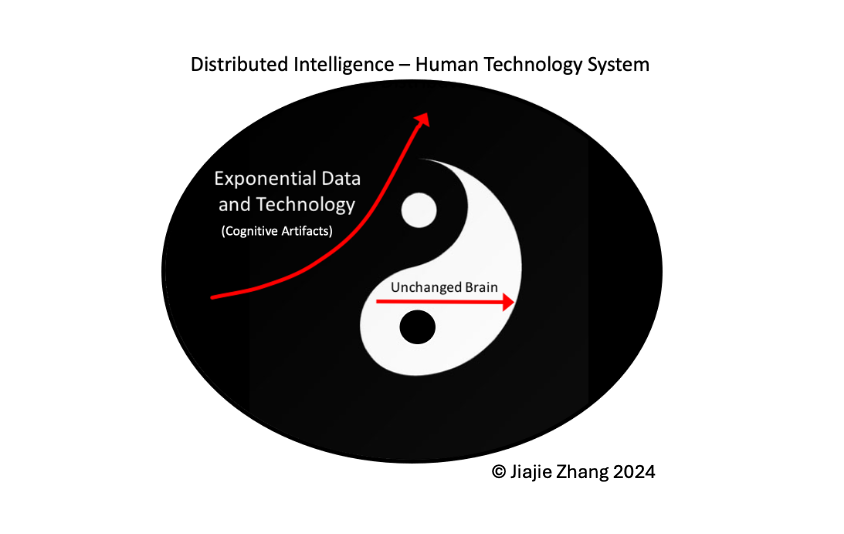
September 26, 2024
Jiajie Zhang, PhD
Dean and Professor
Glassell Family Foundation Distinguished Chair in Informatics Excellence
McWilliams School of Biomedical Informatics
University of Texas Health Science Center at Houston (UTHealth Houston)
In light of the rapid advancements in artificial intelligence (AI), particularly in the development of large language models (LLMs) such as ChatGPT, there has emerged a growing narrative suggesting that AI is on the cusp of surpassing human intelligence in the form of Artificial General Intelligence (AGI). However, concerns regarding an imminent AI singularity apocalypse are unfounded and should not cause undue alarm. The notion that AGI will replace human beings entirely is a profound misinterpretation of the nature and function of cognitive artifacts throughout our evolutionary history and their essential role in augmenting human intellect.
Cognitive artifacts are sophisticated tools created by humans to augment human cognitive processes, enhancing rather than replacing our intellectual capabilities (Norman, D. A., 1993). These artifacts have been integral to human development, from the early use of stones for counting to advanced computing devices of today. Each iteration has served as an extension of our cognitive faculties, facilitating tasks that would be arduous or impossible to perform unaided. For instance, the abacus allowed for complex calculations long before the advent of modern calculators, demonstrating an early form of cognitive augmentation. Similarly, the development of written language revolutionized communication, enabling the recording and dissemination of knowledge across generations. Mathematics provided a foundational framework for logical reasoning and scientific discovery, underpinning technological advancements that continue to shape our world.
Large Language Models (LLMs) and contemporary AI represent the latest evolution in this continuum of cognitive artifacts. These powerful systems are designed to assist with vast data processing and complex problem-solving, tasks that are beyond the capacity of the unaided human brain. However, it is crucial to recognize that these AI tools are not independent entities. They are deeply integrated with human input and guidance, functioning as collaborative partners as Distributed Intelligence (Zhang, J. & Norman, D. A., 1994).
By leveraging the external capabilities of AI, we amplify the internal processing power of the human brain, achieving a synergy that neither could accomplish independently. This partnership exemplifies the dynamic interplay between rapidly advancing technology and the relatively stable nature of human cognition. Far from eclipsing human intelligence, AI serves to enhance and extend our cognitive abilities, reinforcing the symbiotic relationship between human minds and the tools they create.
The Ying-Yang diagram illustrates the basic ideas of Distributed Intelligence by showing the dynamic interplay between rapidly advancing cognitive artifacts (black portion) and the relatively stable nature of human biological brain (white portion). The cognitive capacities of the human biological brain are basically unchanged over the millennia, whereas data and technology outside of the human brain have accelerated exponentially over the past few decades (Stead, W. et al., 2011). Although the biological brain does not change much, the Distributed Intelligence System composed of brain and technology grows exponentially in both capacity and ability. Additionally, while technology is growing at an unprecedented rate, this does not equate to a surpassing of human cognitive abilities, but rather an augmentation of them. Cognitive artifacts serve to amplify human intelligence by converging the external capabilities of technology with the internal processing power of the human brain. The yin-yang represents the balance and synergy between human intelligence and cognitive artifacts. Tools like LLMs are not independent entities but are deeply integrated with and dependent on human guidance and input. AI, as embodied by LLMs and other cognitive artifacts, is not on a trajectory to overtake human intelligence but to collaborate with and enhance it within a system of distributed intelligence. The interdependence between human cognitive processes and technological advancements is a dance of balance and mutual enhancement, not a race towards obsolescence of the human element.
Although AI Supremacy is a myth, the cognitive seachange elicited by the AI Revolution is real. It is as fundamental as the other major socio-economic transformations in recorded human history. With its biologic focus, the Agricultural Revolution helped liberate hunter/gatherers from food scarcity and uncertainty through the raising of crops and the domestication of animals. Physical in nature, the Industrial Revolution began to free us from grueling physical labor. The AI Revolution, which at its core is about accelerating human cognition through technological means, is liberating us from certain types of cognitive labor. Fueled by powerful computing, innovative algorithms, and massive data, the AI Revolution is as significant as the Agricultural and Industrial Revolutions, for it is transforming the way we approach, handle, analyze, and use vast amounts of information; altering the ways in which we think, reason, solve problems, and make decisions; and, of course, it is irrevocably leading to seismic changes in how we work, obtain health care, make scientific discoveries, learn, entertain, and, simply, live. Today, we are at the “James Watt” moment for cognition.
The AI Revolution is indeed liberating us from certain cognitive work, but as we stand in awe of its power, we must not lose sight of its limitations. Through AI, we can process vast amounts of data and perform tasks with an efficiency that outstrips human speed and capacity, yet AI cannot encompass the profundity of human thought or the breadth of human understanding.
As we navigate the AI Revolution, it is imperative that we maintain a balanced perspective. AI will undoubtedly shape our future, but should not define it. The role of AI is to serve and benefit humanity, not dwarf or control it. We must continue to value the unique qualities of the human mind and spirit, which are the originators of cognitive artifacts and the true drivers of innovation.
By fostering an environment where AI supports—rather than supersedes—human cognition, we can ensure that the AI Revolution benefits all of humanity, not just the processors and programs that seem poised to lead it.
Let us then, as a Society, commit to forging a future where we walk alongside our creations, not in their shadow.
References: